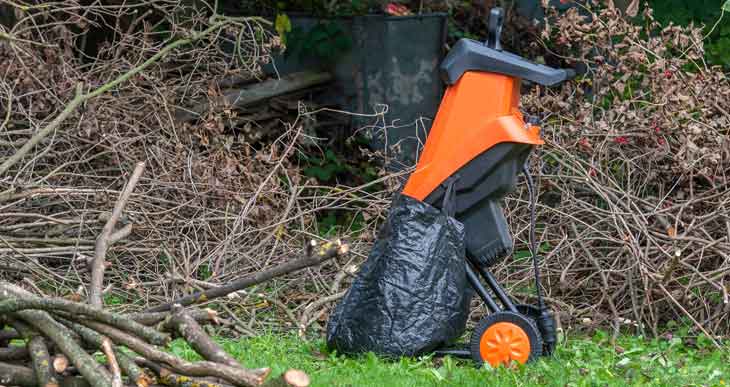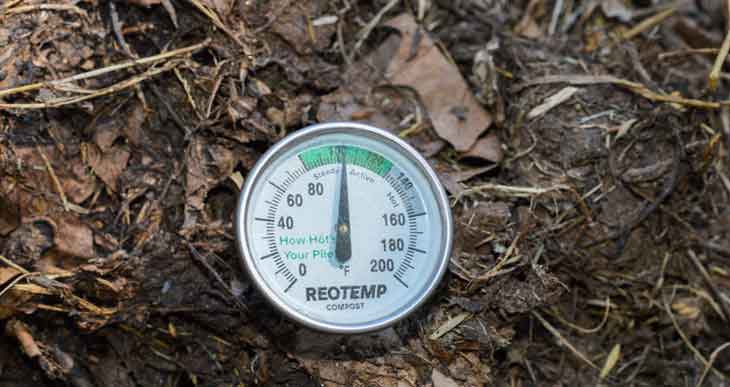Compost Tools (The Best Gear for Home Composting)

It’s not hard to make compost.
In fact, it’s one of the simplest things you can do for your garden. All you need is a little bit of space, some essential compost tools, and patience.
In this article, I’ll discuss the essential compost equipment you need to get started and how to use it to make perfect compost every time!
With this gear, you’ll be able to create nutrient-rich soil for your garden in no time!
Compost Tools and Equipment
The best gear for successful composting includes a combination of everyday gardening equipment plus a few specialized compost tools. And if you choose wisely, it will last you a very long time.
Some of the tools you need for good composting are probably already part of your everyday gardening equipment. For example, you most likely have a spade, pitchfork, gloves, and a wheelbarrow.
But there are also a few specialized compost tools that help make the composting process go more smoothly.
It’s true… You can get by with a minimum of paraphernalia.
But having the right tools for the job will make life much easier!
What tools are best for composting?
There’s a massive assortment of composting supplies on the market, and the choice can be overwhelming. A quick google search will yield thousands of results!
The checklist of equipment below has been selected from experience and careful consideration. Think of this as a starting point for putting together your own compost kit.
Every stage of composting requires a specific piece of equipment that is best suited to the task.
So I’ve compiled this list logically from the start of the process to the end, beginning with collecting waste materials, maintaining and monitoring your compost, and finally harvesting and using the end result.
I’ve also included a few extra suggestions to make your composting experience more enjoyable!
A quick heads-up: this article includes some affiliate links. These cost you nothing, but I get compensated for referring traffic.
Tools for preparing compost materials:
The organic waste materials used to make home compost generally come from the kitchen and the garden. Just about anything organic can be added to your compost recipe. In fact, the greater the variety of waste matter, the better and richer the end product.
Kit for kitchen compost waste:
For most of us, collecting compost materials begins in the kitchen.
In general, you’ll need a container to collect food scraps and something to chop them up with.
The smaller the materials are, the quicker they break down into valuable compost. This is because when it’s sliced up, it has a much larger surface area for the composting microbes to work on.
Countertop Compost Pail or Bin
One of the first choices is what kind of container you want to use to hold your compost waste between trips to your outdoor composter.
In fact, having a designated container for kitchen leftovers will make you much more likely to compost your waste and less likely to put it in the trash.
Your options range from a simple bucket to a fancy countertop container. Begin by considering where to keep it (on the countertop, under the counter, or on the floor).
Having something on the countertop is handy for when you’re preparing meals. Just scrape the scraps into the container and forget about it until it’s full. A lid is essential if you want to keep fruit flies away from your leftovers.

Some of the better models like this one also have a fancy carbon filter that allows the leftovers to breathe but prevents offensive smells.
If you cook as much as I do, these things fill up really quickly. So my advice is, bigger is better!
A good solution is to use a second small garbage bin like this. This is especially useful during the cold winter months when you’re less likely to want to go outside to visit your compost heap!
A separate bin with a removable plastic insert for carrying stuff out to the compost pile is ideal. This is the kind of thing I use
Keep in mind that food scraps get pretty soggy inside these containers. So it’s wise to line the inside of the container to prevent you from having to wash it out every time you empty it. You can use newspaper to line the interior. The advantage is it can just be thrown in the compost bin with the rest of the fruit and veggies!
Alternatively, use compostable food scrap bags like these.
If you’re worried about fruit flies and bad smells, consider putting your scraps in the freezer until you’re ready to take them outside.
This specially designed Freezer compost bin does the job perfectly!
Remember…
Whatever you put in your container, you should chop it up into smaller pieces first. Microbes will feed on anything organic, but breaking things down into small parts will accelerate the decomposition process if you want them to eat faster.
A good knife and a chopping board will do the trick. But if you’re a lazy composter (no judgment, I promise …) I know of some gardeners who use a blender to grind up their food waste before storing it in a container!
Just drop it in and give it a whirl – it’s that easy.
kitchen food recycler
Ok, I admit it!
I’m a sucker for gadgets…
Suppose you’re thinking of investing in a state-of-the-art electric kitchen composter. In that case, you might be wondering about the ecological advantages of these machines.
I’m talking about devices like this one… (Vitamix Foodcycler)
I had doubts about their carbon footprint, but it turns out that they still provide a small benefit in terms of CO2 emissions relative to sending waste to landfills.
And they drastically speed up the composting process!
Also, devices like this present advantages for people who have limited space for composting or don’t have a backyard. They can also compost more types of food waste like meat, which is challenging to compost in a backyard composter.
So electric food recyclers could be a good option if you’re looking for an easy and efficient way to compost your kitchen scraps.
Gear for preparing yard materials:
In the same way, you need to chop up your kitchen leftovers, you also need to shred garden waste into smaller particles.
You have a few options, ranging from hard work to easy peasy!
The first is to chop things up by hand. A garden machete is probably the best tool for chopping up just about anything! This is the cheapest and simplest option for cutting up yard materials.
For safety, go for machetes like this with a nonslip handle.
If all that sounds like a lot of hard work, you could consider investing in a garden shredder or compost chipper.
Unless it’s grass clippings (which are already chopped up), just about everything you compost will benefit from being shredded. That includes things like:
- Dead leaves: shredding them helps fluff them up and prevents them from clumping together.
- Small twigs: hard woody materials take a long time to break down in compost, so chipping them into small pieces accelerates decomposition.
- Larger branches: these are the kind of things that remain in compost for a long time because they rot slowly. The smaller they are, the better.
So, you need a shredder that can handle a variety of materials without much difficulty.
How do you shred compost materials?

And in all honestly, a shredder is perhaps the one piece of garden equipment that will make you beam with delight! It’s incredibly satisfying watching that huge pile of branches and leaves reduced to a fraction of its size in seconds!
There are lots of different types and models on the market. But for average home composting needs, I recommend something like this electric power chipper shredder.
It’s easy to use, not too expensive and will make light work of any garden waste you need to compost.
A chipper shredder will dramatically reduce the time it takes to compost stuff.
Tip: you can also produce some beneficial mulch from your dry yard trimmings.
If you have a very big yard and a lot of material to compost, you will benefit from getting a larger model.
This heavy-duty wood chipper has the advantage of a powerful gas-powered engine. As a result, it can be used anywhere in your yard without needing an electrical outlet.
If a shredder is beyond your budget, a good mulching lawnmower will also do a great job of reducing the size of leaves.
As you move around the garden collecting waste, I like to use big reusable yard waste bags like these. I like the way they fold up for easy storage.
Tools for compost maintenance:

Now that you have everything in the compost pile, you have to take care of your compost. Some of the tools you need for this phase are more specific.
Gloves
Ok, so this is pretty obvious. You probably already wear gloves to protect your hands when working in the yard. This is a reminder to make sure you wear gloves whenever you work on your compost.
Unfinished compost and decomposing waste can contain potentially harmful pathogens and fungi.
Keep your hands protected with a pair of rubber-coated gloves like these, and wash your hands directly after handling compost.
Compost aerator tools
Turning compost is an essential part of maintaining a healthy compost pile. Turning encourages airflow, and if decomposing materials don’t get enough oxygen, they turn anaerobic (no oxygen). Unfortunately, this kind of decomposition produces bad smells and by-products that can actually harm plants.
The most basic aerator tool is a pitchfork.
I recommend investing in a heavy-duty model. I’ve known pitchforks to break when used on tough ground. This one has a steel shaft and tines and is perfect for tasks like turning compost.
You can also buy devices that are designed explicitly for aerating compost.
The good news is that compost aerator tools like this are easier to use than a pitchfork and especially useful in enclosed containers like compost bins. They have a point that penetrates deep into the compost to aerate from the bottom up and help to fluff up the compost heap.
Rainwater barrel
Part of compost maintenance includes adding water to keep the moisture levels up.
The significant advantage of rainwater is it doesn’t contain chlorine. This makes it ideal for adding moisture to compost without disturbing the beneficial microbial activity in the pile (It’s also great for your plants!).
A rain barrel is a great way to collect water for your compost and save money on your water bill at the same time.
This model is made with BPA-free materials.
Tools for monitoring compost:

Suppose you want to keep a close eye on your compost to ensure conditions are ideal for everything to rot properly. In that case, there are a few parameters you can measure:
- temperature
- moisture
- Acidity/alkalinity
Compost Thermometer
The first important factor is temperature. The temperature inside your pile tells you a lot about the activity of the composting microbes. Monitoring temperature can help maintain a fast compost heap and judge exactly the right moment for turning the pile. For this, you need a special compost thermometer.
Ideally, you want one that has a long probe like this.
Compost moisture meter
Another critical factor is moisture.
The compost should be moist but not wet. If it’s too dry, the composting process will slow down. If it’s too wet anaerobic conditions can develop, causing unwanted side effects.
You can use a regular soil moisture meter like this one to check the moisture levels of your compost.
pH Compost Tester
The last factor is pH.
Most composts end up slightly alkaline. But you can also influence the acidity of compost by adding certain feedstocks. So depending on the type of plants you want to use your compost on, you may need to monitor the pH level of the finished compost.
You can test the pH of your compost with a simple soil tester like this.
Tools for harvesting and transporting compost:
So now that you have some excellent finished compost, it’s time to put it to use! For this, you need some tools for harvesting and transporting the compost.
Compost Sifter
This is another very satisfying piece of kit!
A compost screener or sifter is like a giant sieve that removes the large unfinished particles from your compost. Things like fruit pits and big sticks that haven’t finished rotting.
You put a lot of hard work into making your compost. It always fills me with pleasure to see the refined results after screening finished compost. It looks fantastic!
A good sifter like this is designed to fit snuggly onto a wheelbarrow. You can then shovel your compost from the pile and throw back anything unfinished.
Wheelbarrow

That brings us neatly to another piece of invaluable composting equipment – the wheelbarrow.
Wheelbarrows were invented many generations ago. And there’s a perfect reason for using these! Moving your slightly wet, heavy finished compost to the place you want to use it requires a suitable method of transport.
This one has a 400 lb capacity.
And if you want to get your kids involved, try this cute junior-sized wheelbarrow!
Additional tools for composting
Aside from the checklist above, there are a few additional items to consider. These are some of the little extras I regularly use in the compost making process:
- Leaf rake
- Pruners
- Hand fork
You absolutely need to rake up all those precious dead leaves in the fall. In addition, you should store leaves for composting over the coming season because you can quickly run out of a good source of carbon materials at certain times of the year.
Semi-flexible rakes are great for sweeping up big piles of leaves. You can also use them to apply compost to lawns as a turf dressing.
Tip: get the kids involved! They’ll have loads of fun, and your back will be saved.
Pruners are essential for trimming plants. All those trimmings can go on your compost pile.
A good pair of hand pruners like these make garden work more comfortable.
When adding new waste to the compost pile (especially kitchen scraps), you sometimes need to push aside the top layers of compost to bury the leftovers.
I’ve had a few very unpleasant surprises when doing this by hand and finding something gluey and smelly in the rotting process!
A hand-held cultivator or garden fork is a valuable extension to your hand and arm.
So there you have it!
The essential compost tools kit for making perfect compost at home. If I come across any new and unique ideas for compost equipment, I will add them to this list 🙂
Happy composting!







